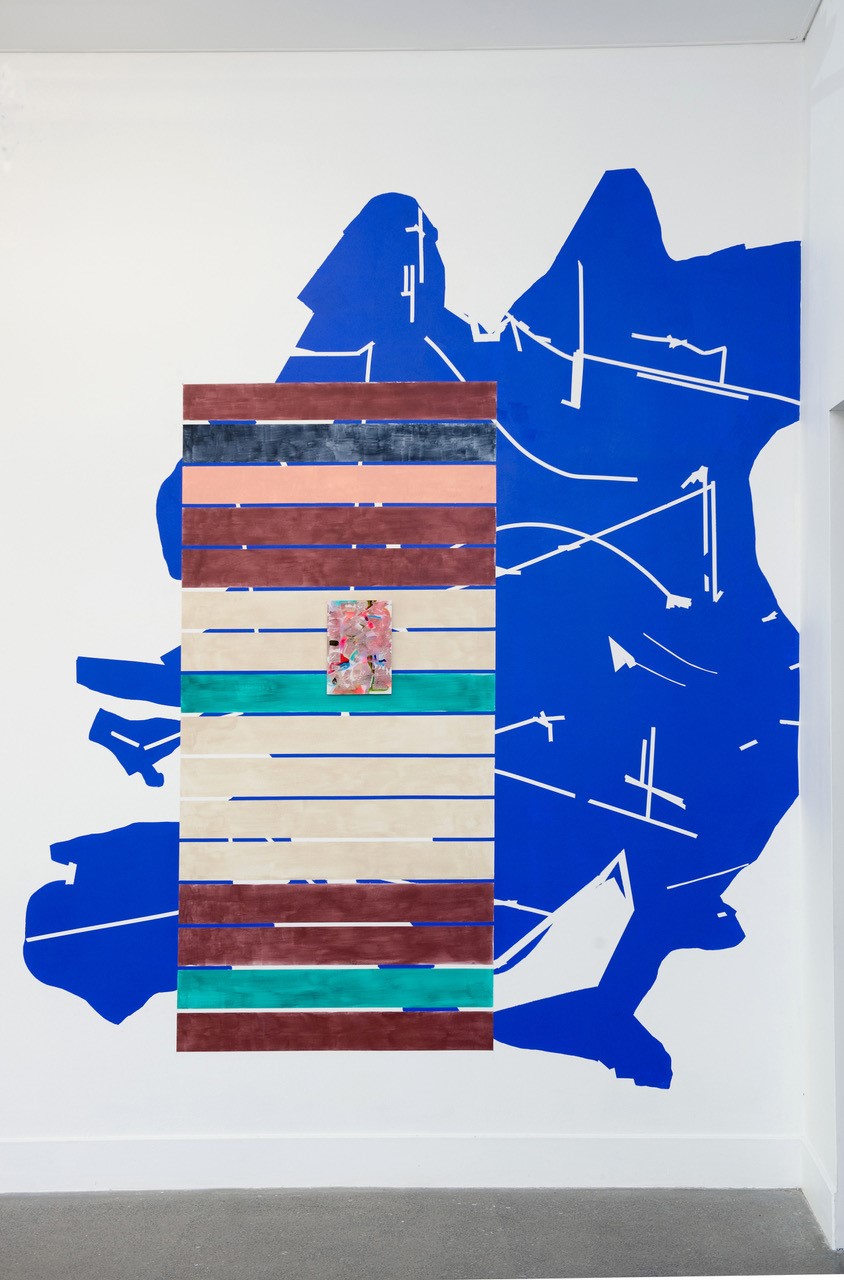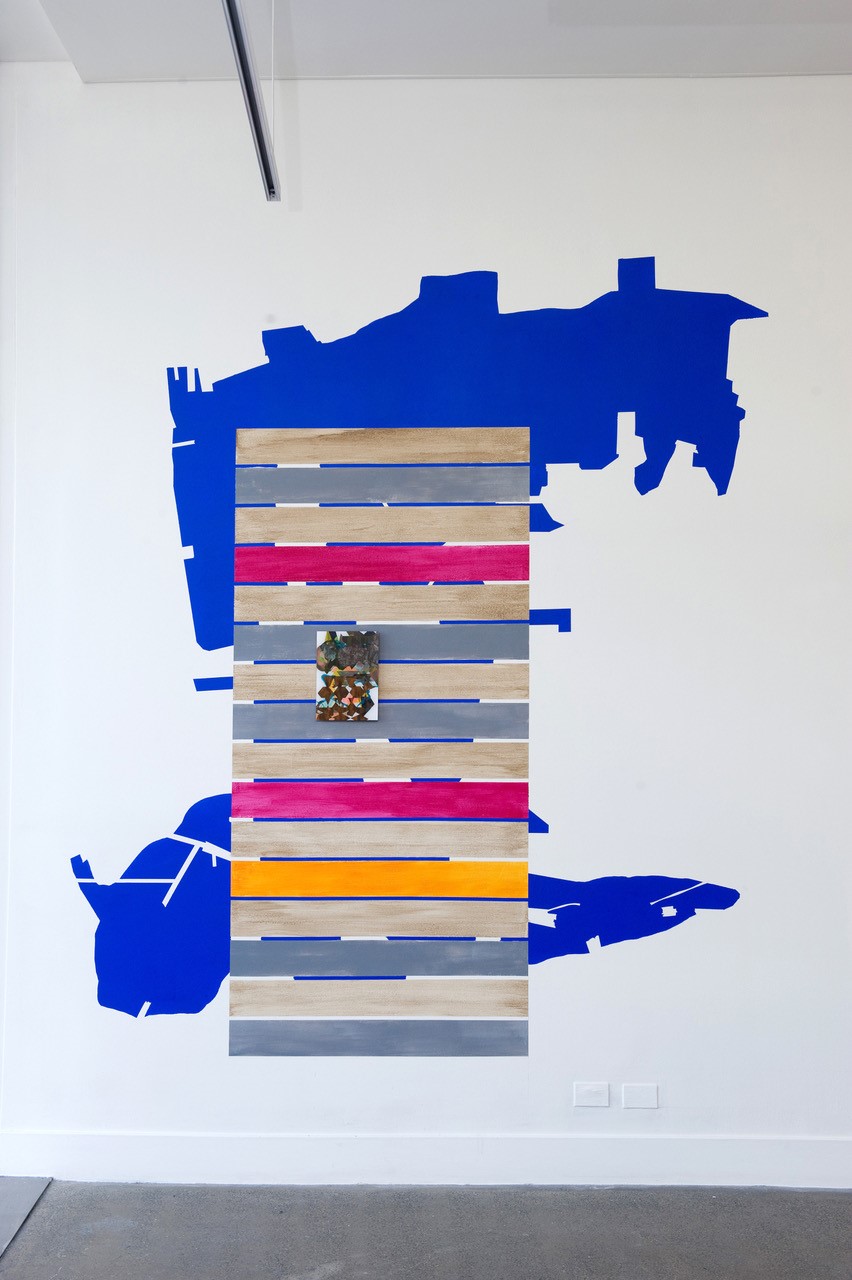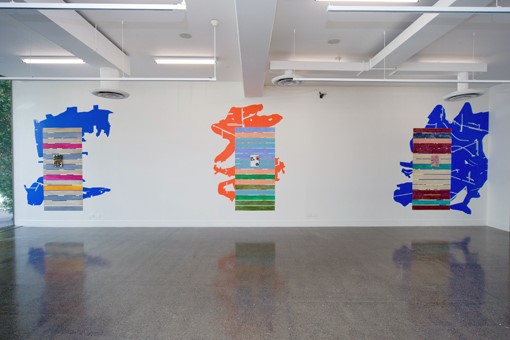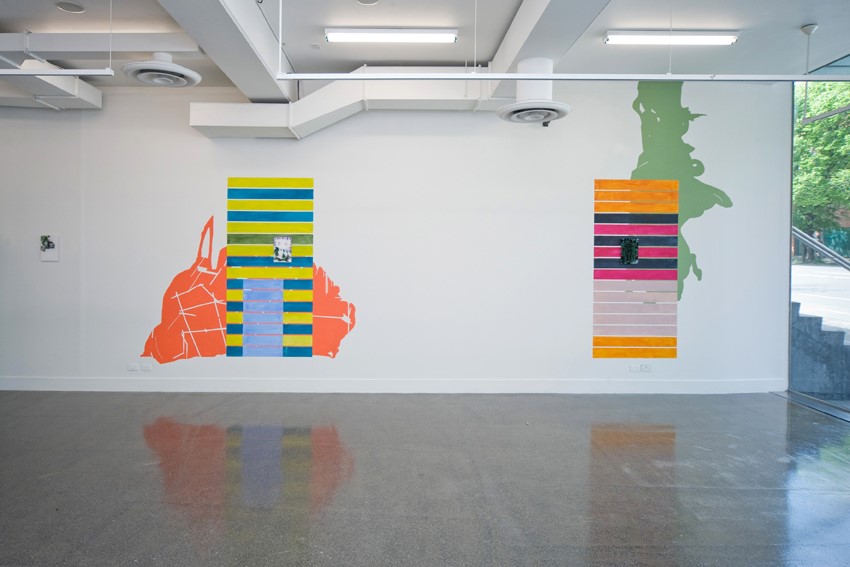Can this be a painting?
Originally published at intersect.rmit.edu.au

Michael Jäger, SWOOP, 2010.

Michael Jäger, SWOOP, 2010.

Michael Jäger, The Desire to be Elsewhere, 2010, installation view.

Michael Jäger, The Desire to be Elsewhere, 2010, installation view.
Michael Jäger's paintings don't stop but rather, they reach an edge. And from that edge he thinks about how to re-open or move beyond.
We understand the absolute authority of two straight lines converging together to form a corner and that the perimeter of something is a space to consider. The laws of physics determine that the sheet of glass that both illuminates and shields Jäger's paintings must end with sharpness—something that we can intuitively feel within our fingertips. The blue line painted on the glass will not continue, the spill of hot pink paint will stop, while the seemingly indiscriminate, wild, jewel-like paint will eventually befall reason and logic as it encounters the edge of constructed space. However, these paintings also don't ever really end, they're expansive and they reverberate in every direction.
There are difficulties in thinking about Jäger's work in any one particular way. In order to be rendered comprehensible, to be able to fit within a definition we can make sense of, Jäger's paintings are in part contained within parameters we understand.
We understand the gallery wall. It is the thing that sits behind the art. It is the larger contextual frame that we see but aren't supposed to notice. Jäger's painting engages with and travels further than the physical confines of actual space. During installation he invariably extends his work through the stratagem of painting onto the walls of the gallery. He re-opens what he has initially finished or dispensed with in the small painted glass panels in the studio, implying that nothing in this way of thinking is ever finished, or complete. He considers his glass works as a point or opportunity from which to continue, to flow into something larger, something impermanent and conceptually open-ended. At this point everything changes, posing the obvious question: where is the painting and where is the wall? Well we know which is which, but Jäger poses a question about some other possibility. We know that this wall will not stay this or that colour. We understand that the walls will return to their unobtrusive state, the seamless and homogenous space that we know as gallery. Jäger asks what is painting to be? Is it the painted rectangle or is it the glass rectangle over a painting? Is the wall painting background and is it second to the painting. Are the small paintings complete when the wall painting no longer accompanies them? And because Jäger paints on the reverse side of the ‘support' and therefore we think of the image in the painting simultaneously as right-way round and in reverse, Jäger positions his painting as an in between state, concurrently verifying and questioning what painting can be.
Every idea hovers for a moment between being something, or being nothing. In recognizing this we ask ourselves in our thinking if we should dismiss the glimpse we may have had of a conception or delve more deeply into thought and allow it to become? This is the question Jäger poses when he asks himself 'can this be a painting?'1
In approaching Jäger's work and thinking about it as a series of moments, ideas or thoughts that might be, we understand that his stratagem is not one of absolute conceptions, but rather is more concerned with the fluid and varied nature of thought within the preoccupation of thinking through painting. The strict formalist pursuit of a vision that is clear and precise that has defined a particular tradition of abstraction doesn't operate in these paintings. Jäger's paintings are not about arriving at a conclusion. They are akin to a broken kaleidescope that, with each turn of the wheel, allows the glitter and the beads to form and reform themselves with progressively more abandon.
These paintings are ideas about paintings.
Painting on glass requires a reversal of thought. Because we can see through the painting from behind, the conventional process of working towards an image is not possible. The idea that a mistake can be painted out or hidden underneath another layer of paint doesn't work. In these paintings the first is also the last layer of paint. The top is also the bottom. It is therefore impossible to see these paintings as something simple. We are seduced by their beauty and then denied access to their content. Held at arms length behind the glass we have no option but to look, and to look and to look. Gazing deeper and seeing more. At what point then do we see the nothingness in these pictures? Jolted out of our reverie by the reflection on the glass of a movement behind us, we turn around to look out from the painting and into the painted room. Looking back at the surface we return with a shock to their slightness: they are after all just marks and daubs of colour. Comprehending at once that there is no one thing to understand, only the unstable world and a state of being in-between.
Thinking in-between the present and the past.
These paintings have a sense of being a selection of moments in the history of painting, or fragments of collage, cut out, mixed up and spilt across their glass base or cover. In some ways they can also be likened to a photographic process by which an image is captured, reversed, reversed again and made to appear, with the glossy surface a reminder of the implied seamless perfection of the photographic surface. And like photographs Jäger's paintings shift between object and image. As a result of the process of photography by the time the photograph is printed it is already an artifact. Despite the hand-made quality of the paint application in Jäger's paintings, that famous link with the artist's hand that painting allows through its visceral materiality is denied to us. The act of painting is a memory in these pictures, embedded in their syntax, obviously of primary importance, but not given primacy. In part they appear to be a type of contained evidence behind glass, a capturing of something in painting.
Jäger's works are in every sense contradictory—the works on glass suggest something that was, and not is, while the wall painting suggests something momentary. And through our sentient awareness of the infinite possibilities within this work, the almost perplexed intrigue we all experience in thinking about the strategy of working backwards and away from the surface, coupled with the way this work extends outside of the paintings, each of Jäger's painted installations seem to be about a chaotic narrative that leads to clarity.
The question Jäger poses can this be a painting is the question that all painters have asked themselves, and the answer is of-course more simple than we imagine. If the function of art is to create questions, to avoid obvious and rigid solutions and to challenge us to think about the things we don't think about such as gallery walls and authorship and edges and beginnings and endings then yes, this can be a painting and painting can and must be this.
Julia Powles and Peter Westwood.
Notes:
We understand the absolute authority of two straight lines converging together to form a corner and that the perimeter of something is a space to consider. The laws of physics determine that the sheet of glass that both illuminates and shields Jäger's paintings must end with sharpness—something that we can intuitively feel within our fingertips. The blue line painted on the glass will not continue, the spill of hot pink paint will stop, while the seemingly indiscriminate, wild, jewel-like paint will eventually befall reason and logic as it encounters the edge of constructed space. However, these paintings also don't ever really end, they're expansive and they reverberate in every direction.
There are difficulties in thinking about Jäger's work in any one particular way. In order to be rendered comprehensible, to be able to fit within a definition we can make sense of, Jäger's paintings are in part contained within parameters we understand.
We understand the gallery wall. It is the thing that sits behind the art. It is the larger contextual frame that we see but aren't supposed to notice. Jäger's painting engages with and travels further than the physical confines of actual space. During installation he invariably extends his work through the stratagem of painting onto the walls of the gallery. He re-opens what he has initially finished or dispensed with in the small painted glass panels in the studio, implying that nothing in this way of thinking is ever finished, or complete. He considers his glass works as a point or opportunity from which to continue, to flow into something larger, something impermanent and conceptually open-ended. At this point everything changes, posing the obvious question: where is the painting and where is the wall? Well we know which is which, but Jäger poses a question about some other possibility. We know that this wall will not stay this or that colour. We understand that the walls will return to their unobtrusive state, the seamless and homogenous space that we know as gallery. Jäger asks what is painting to be? Is it the painted rectangle or is it the glass rectangle over a painting? Is the wall painting background and is it second to the painting. Are the small paintings complete when the wall painting no longer accompanies them? And because Jäger paints on the reverse side of the ‘support' and therefore we think of the image in the painting simultaneously as right-way round and in reverse, Jäger positions his painting as an in between state, concurrently verifying and questioning what painting can be.
Every idea hovers for a moment between being something, or being nothing. In recognizing this we ask ourselves in our thinking if we should dismiss the glimpse we may have had of a conception or delve more deeply into thought and allow it to become? This is the question Jäger poses when he asks himself 'can this be a painting?'1
In approaching Jäger's work and thinking about it as a series of moments, ideas or thoughts that might be, we understand that his stratagem is not one of absolute conceptions, but rather is more concerned with the fluid and varied nature of thought within the preoccupation of thinking through painting. The strict formalist pursuit of a vision that is clear and precise that has defined a particular tradition of abstraction doesn't operate in these paintings. Jäger's paintings are not about arriving at a conclusion. They are akin to a broken kaleidescope that, with each turn of the wheel, allows the glitter and the beads to form and reform themselves with progressively more abandon.
These paintings are ideas about paintings.
Painting on glass requires a reversal of thought. Because we can see through the painting from behind, the conventional process of working towards an image is not possible. The idea that a mistake can be painted out or hidden underneath another layer of paint doesn't work. In these paintings the first is also the last layer of paint. The top is also the bottom. It is therefore impossible to see these paintings as something simple. We are seduced by their beauty and then denied access to their content. Held at arms length behind the glass we have no option but to look, and to look and to look. Gazing deeper and seeing more. At what point then do we see the nothingness in these pictures? Jolted out of our reverie by the reflection on the glass of a movement behind us, we turn around to look out from the painting and into the painted room. Looking back at the surface we return with a shock to their slightness: they are after all just marks and daubs of colour. Comprehending at once that there is no one thing to understand, only the unstable world and a state of being in-between.
Thinking in-between the present and the past.
These paintings have a sense of being a selection of moments in the history of painting, or fragments of collage, cut out, mixed up and spilt across their glass base or cover. In some ways they can also be likened to a photographic process by which an image is captured, reversed, reversed again and made to appear, with the glossy surface a reminder of the implied seamless perfection of the photographic surface. And like photographs Jäger's paintings shift between object and image. As a result of the process of photography by the time the photograph is printed it is already an artifact. Despite the hand-made quality of the paint application in Jäger's paintings, that famous link with the artist's hand that painting allows through its visceral materiality is denied to us. The act of painting is a memory in these pictures, embedded in their syntax, obviously of primary importance, but not given primacy. In part they appear to be a type of contained evidence behind glass, a capturing of something in painting.
Jäger's works are in every sense contradictory—the works on glass suggest something that was, and not is, while the wall painting suggests something momentary. And through our sentient awareness of the infinite possibilities within this work, the almost perplexed intrigue we all experience in thinking about the strategy of working backwards and away from the surface, coupled with the way this work extends outside of the paintings, each of Jäger's painted installations seem to be about a chaotic narrative that leads to clarity.
The question Jäger poses can this be a painting is the question that all painters have asked themselves, and the answer is of-course more simple than we imagine. If the function of art is to create questions, to avoid obvious and rigid solutions and to challenge us to think about the things we don't think about such as gallery walls and authorship and edges and beginnings and endings then yes, this can be a painting and painting can and must be this.
Julia Powles and Peter Westwood.
Julia Powles is an artist based in Melbourne. Peter Westwood is Coordinator of the Artist in Residence Program in the School of Art at RMIT University. He is an artist, writer and curator based in Melbourne.
Notes:
- Michael Jäger in conversation with Peter Westwood and Julia Powles, Melbourne. September 2010